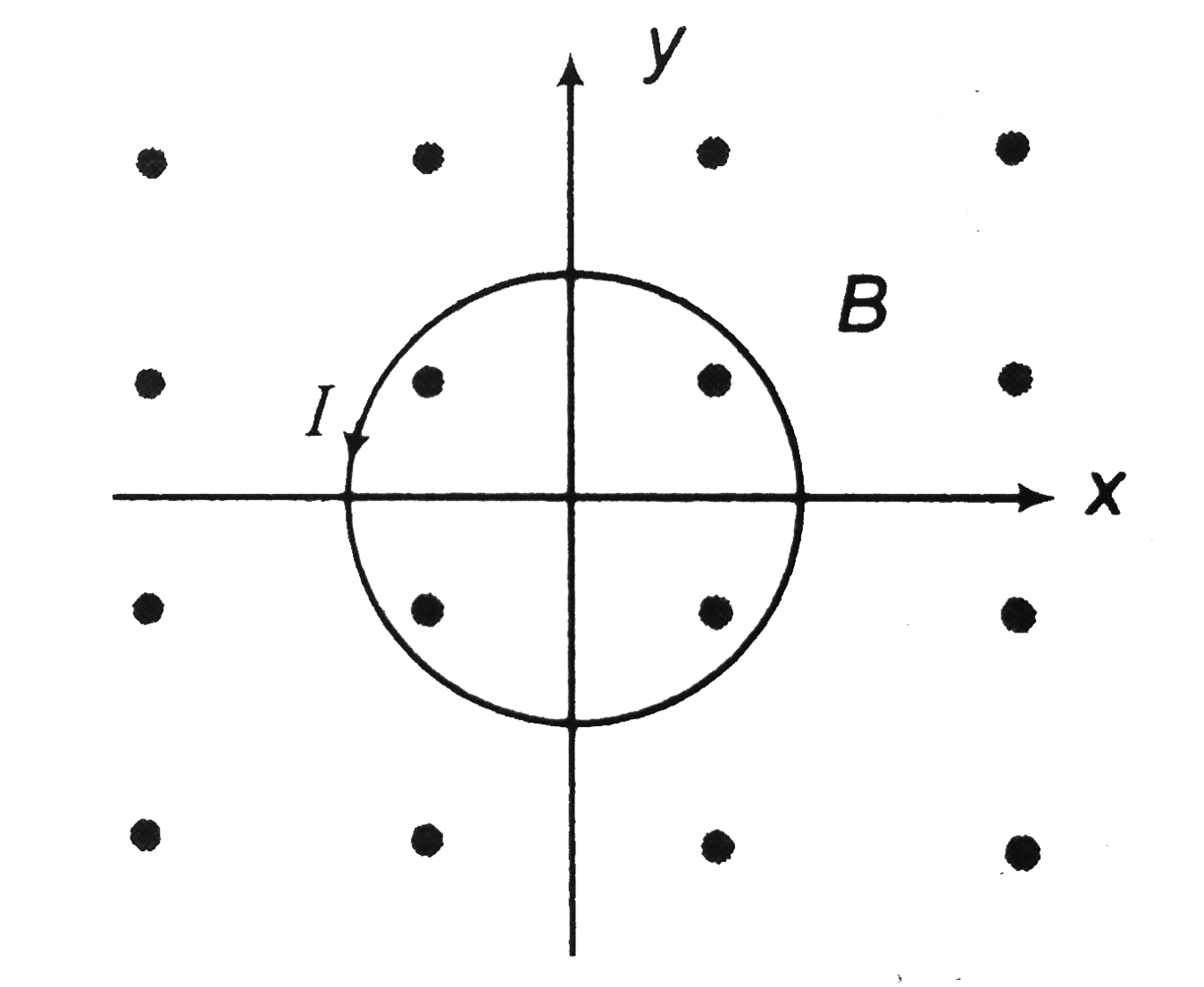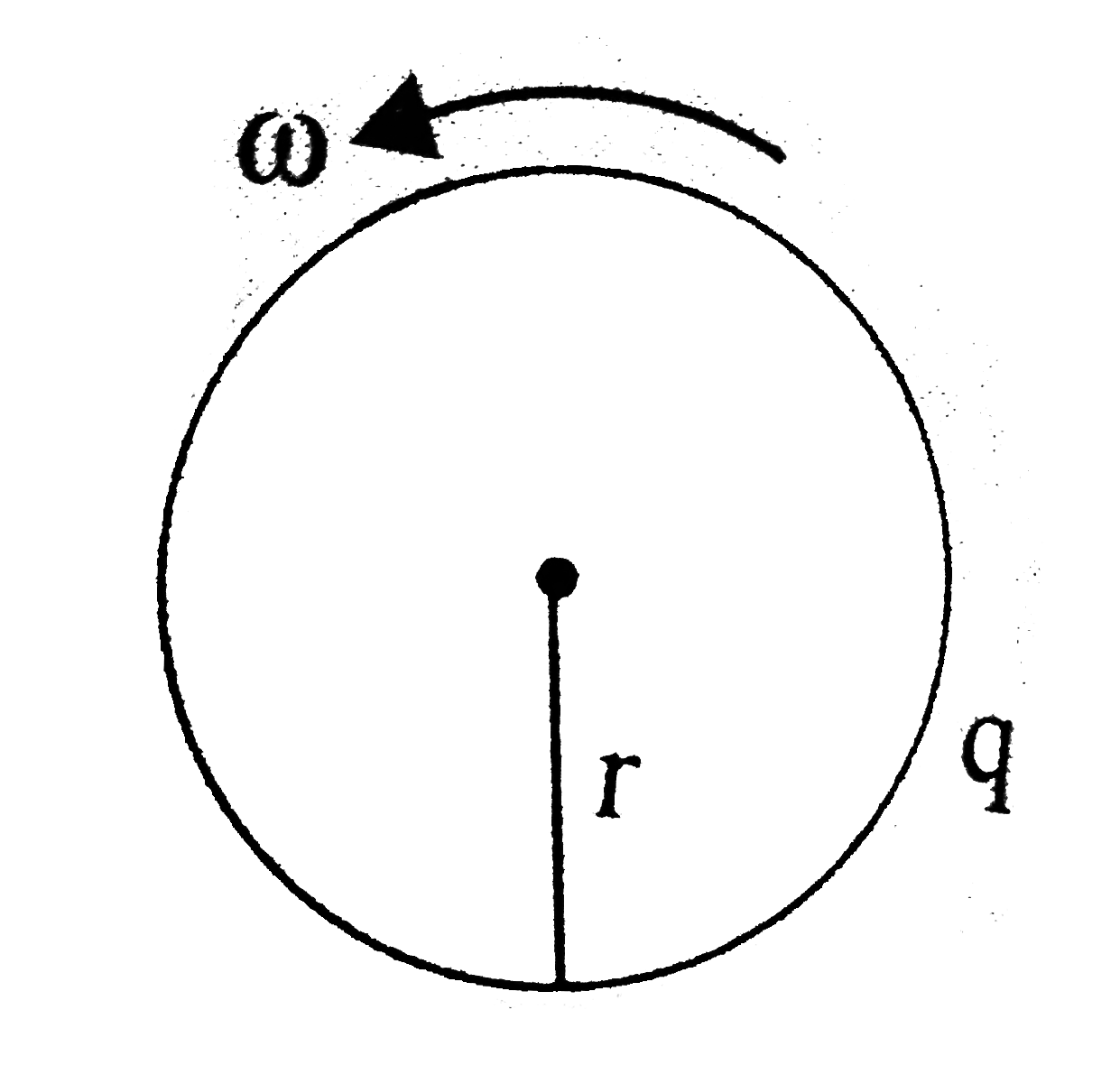A point charges Q is moving in a circular orbit of radius R in the x-y plane with an angular velocity ω. This can be considered as equivalent to a loop carrying a steady current Qω2π. S uniform magnetic field along the positive z-axis is now switched on, which increases at a constant rate from 0 to B in one second. Assume that the radius of hte orbit remains constant. The application of hte magnetic field induces an emf in the orbit. The induced emf is defined as the work done by an induced electric field in moving a unit positive charge around a closed loop. It si known that, for an orbiting charge, the magnetic dipole moment is proportional to the angular momentum with a porportionality constant λ.
The charge in the magnetic dipole moment associated with the orbit. at the end of the time interval of hte magnetic field charge, is
−γBQR2
−γBQR22
γBQR22
γBQR2
The correct Answer is:B
To solve the problem, we need to find the change in the magnetic dipole moment associated with a point charge Q moving in a circular orbit under the influence of a changing magnetic field. Here's a step-by-step breakdown of the solution:
Step 1: Understanding the Current Equivalent
The point charge Q moving in a circular orbit of radius R with angular velocity ω can be treated as a loop carrying a steady current. The current I can be calculated as:
I=Qω2π
Step 2: Rate of Change of Magnetic Field
The magnetic field B is switched on and increases at a constant rate from 0 to B in 1 second. Thus, the rate of change of the magnetic field is:
dBdt=B−01−0=B
Step 3: Induced EMF Calculation
The induced EMF (E) in the loop can be calculated using Faraday's law of electromagnetic induction:
E=−dΦdt
where Φ is the magnetic flux. The magnetic flux Φ through the loop is given by:
Φ=B⋅A=B⋅πR2
Thus, the induced EMF becomes:
E=−ddt(B⋅πR2)=−πR2dBdt
Substituting dBdt=B:
E=−πR2B
Step 4: Electric Field Calculation
The induced electric field E around the loop can be related to the EMF:
E=E⋅(2πR)
Thus, we can express the electric field as:
E=E2πR=−πR2B2πR=−RB2
Step 5: Torque Calculation
The torque τ acting on the charge due to the electric field is given by:
τ=F⋅R
where F is the force acting on the charge, which is:
F=Q⋅E=Q(−RB2)=−QRB2
Thus, the torque becomes:
τ=−QRB2⋅R=−QR2B2
Step 6: Change in Angular Momentum
The change in angular momentum ΔL can be expressed as:
ΔL=τ⋅dt
Over the time interval of 1 second:
ΔL=−QR2B2⋅1=−QR2B2
Step 7: Change in Magnetic Dipole Moment
The magnetic dipole moment m is related to angular momentum L by:
m=λL
Thus, the change in magnetic dipole moment is:
Δm=λΔL=λ(−QR2B2)=−λQR2B2
Final Answer
The change in the magnetic dipole moment associated with the orbit at the end of the time interval is:
Δm=−λQR2B2
---
The point charge Q moving in a circular orbit of radius R with angular velocity ω can be treated as a loop carrying a steady current. The current I can be calculated as:
I=Qω2π
The magnetic field B is switched on and increases at a constant rate from 0 to B in 1 second. Thus, the rate of change of the magnetic field is:
dBdt=B−01−0=B
The induced EMF (E) in the loop can be calculated using Faraday's law of electromagnetic induction:
E=−dΦdt
where Φ is the magnetic flux. The magnetic flux Φ through the loop is given by:
Φ=B⋅A=B⋅πR2
Thus, the induced EMF becomes:
E=−ddt(B⋅πR2)=−πR2dBdt
Substituting dBdt=B:
E=−πR2B
The induced electric field E around the loop can be related to the EMF:
E=E⋅(2πR)
Thus, we can express the electric field as:
E=E2πR=−πR2B2πR=−RB2
The torque τ acting on the charge due to the electric field is given by:
τ=F⋅R
where F is the force acting on the charge, which is:
F=Q⋅E=Q(−RB2)=−QRB2
Thus, the torque becomes:
τ=−QRB2⋅R=−QR2B2
The change in angular momentum ΔL can be expressed as:
ΔL=τ⋅dt
Over the time interval of 1 second:
ΔL=−QR2B2⋅1=−QR2B2
The magnetic dipole moment m is related to angular momentum L by:
m=λL
Thus, the change in magnetic dipole moment is:
Δm=λΔL=λ(−QR2B2)=−λQR2B2
The change in the magnetic dipole moment associated with the orbit at the end of the time interval is:
Δm=−λQR2B2
Topper's Solved these Questions
- ELECTROMAGNETIC INDUCTIONBOOK - RESONANCE ENGLISHCHAPTER - ELECTROMAGNETIC INDUCTIONEXERCISE - Exercis-3 PART 2
16 Videos
- ELECTROMAGNETIC INDUCTIONBOOK - RESONANCE ENGLISHCHAPTER - ELECTROMAGNETIC INDUCTIONEXERCISE - Exercis-3 PART 3
16 Videos
- ELECTROMAGNETIC INDUCTIONBOOK - RESONANCE ENGLISHCHAPTER - ELECTROMAGNETIC INDUCTIONEXERCISE - Exercis-2 PART 4
6 Videos
- ELECTRODYNAMICSBOOK - RESONANCE ENGLISHCHAPTER - ELECTRODYNAMICSEXERCISE - Advanced level problems
31 Videos
- ELECTROSTATICSBOOK - RESONANCE ENGLISHCHAPTER - ELECTROSTATICSEXERCISE - HLP
40 Videos
Similar Questions
A point charges Q is moving in a circular orbit of radius R in the x-y plane with an angular velocity ω. This can be considered as equivalent to a loop carrying a steady current Qω2π. S uniform magnetic field along the positive z-axis is now switched on, which increases at a constant rate from 0 to B in one second. Assume that the radius of the orbit remains constant. The application of the magnetic field induces an EMF in the orbit. The induced EMF is defined as the work done by an induced electric field in moving a unit positive charge around a closed loop. It is known that, for an orbiting charge, the magnetic dipole moment is proportional to the angular momentum with a proportionality constant λ. The charge in the magnetic dipole moment associated with the orbit, at the end of the time interval of the magnetic field charge, is
View SolutionA point charges Q is moving in a circular orbit of radius R in the x-y plane with an angular velocity ω. This can be considered as equivalent to a loop carrying a steady current Qω2π. S uniform magnetic field along the positive z-axis is now switched on, which increases at a constant rate from 0 to B in one second. Assume that the radius of hte orbit remains constant. The application of hte magnetic field induces an emf in the orbit. The induced emf is defined as the work done by an induced electric field in moving a unit positive charge around a closed loop. It si known that, for an orbiting charge, the magnetic dipole moment is proportional to the angular momentum with a porportionality constant λ.
The magnitude of the induced electric field in the orbit at any instant of time during the time interval of the mangnetic field change is
View SolutionA point charges Q is moving in a circular orbit of radius R in the x-y plane with an angular velocity ω. This can be considered as equivalent to a loop carrying a steady current Qω2π. S uniform magnetic field along the positive z-axis is now switched on, which increases at a constant rate from 0 to B in one second. Assume that the radius of hte orbit remains constant. The application of hte magnetic field induces an emf in the orbit. The induced emf is defined as the work done by an induced electric field in moving a unit positive charge around a closed loop. It si known that, for an orbiting charge, the magnetic dipole moment is proportional to the angular momentum with a porportionality constant λ.
The magnitude of the induced electric field in the orbit at any instant of time during the time interval of the mangnetic field change is
View SolutionA particle of charge q and mass m moves in a circular orbit of radius r with angular speed ω. The ratio of the magnitude of its magnetic moment to that of its angular momentum depends on
View SolutionA particle of charge q and mass m moves in a circular orbit of radius r with angular speed ω. The ratio of the magnitude of its magnetic moment to that of its angular momentum depends on
View SolutionAn electron moving in a circular orbit of radius R with frequency f. The magnetic field at the centre of the orbit is
View SolutionA semicircular loop of radius R is rotated with an angular velocity ω perpendicular to the plane of a magnetic field B as shown in the figure. Emf Induced in the loop is

View SolutionA circular loop carrying a current I is placed in the xy-plane as shown in figure. A uniform magnetic fied B is oriented along the positive z-axis. The loop tends to

View SolutionA charge q is spread uniformly over an insulated loop of radius r. If it is rotated with an angular velocity ω with respect to normal axis then the magnetic moment of the loop is :
View SolutionA conducting ring of radius r having charge q is rotating with angular velocity ω about its axes. Find the magnetic field at the centre of the ring.

View Solution